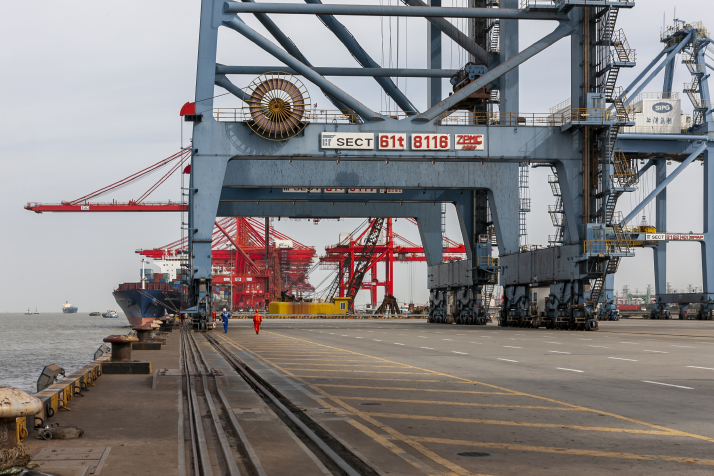| Business |
| Renminbi becomes a bulwark against risks after five years of reform | |
|
|
 The Shanghai Waigaoqiao Port Area (XINHUA)
Since the novel coronavirus disease outbreak this year, major world economies have been in a lockdown and the financial markets are more volatile than market expectations. Consequently, the renminbi (RMB) exchange rate has also been inevitably affected, with larger fluctuations than before. However, according to Zhou Maohua, an analyst with the financial market department of China Everbright Bank, these fluctuations are still the smallest among all major world currency fluctuations."The RMB has become one of the most stable currencies in the world," Zhou told Economic Daily. The stability stems from a reform started five years ago. On August 11, 2015, the People's Bank of China (PBC), China's central bank, announced it was revamping the official central parity of the RMB against the U.S. dollar to better reflect market development in the exchange rate. Effective from that date, the daily central parity quotes reported to the China Foreign Exchange Trade System before the market opened were to be based on the closing rate of the inter-bank foreign exchange rate market on the previous day, supply and demand in the market, and the price movement of major currencies. "Within the past five years, the RMB exchange rate has shown an increasing trend of two-way fluctuations, changing the previous situation of unilateral appreciation or depreciation," Cao Yuanyuan, Director of the Research and Development Department of Golden Credit Rating International, a leading credit rating agency in China, told Securities Daily. She said after the 2015 reform, the RMB exchange rate has become more flexible and the exchange rate regime more transparent and in line with changes in market supply and demand. A shock absorber According to Lian Ping, chief economist of Zhixin Investment, in view of the circulation formed by the yuan's depreciation and capital outflows in 2015-16, the orderly two-way fluctuations in the RMB's exchange rate, and the balance of capital flows against the external turbulences from 2017 to 2020, the exchange rate reform and policy improvement are going in the right direction. Lian said the effects of the exchange rate reform have brought benefits to both the macro and micro aspects of the Chinese economy. For instance, a more flexible RMB will help offset impacts from external economic fluctuations and make the monetary policy better focused on addressing domestic economic difficulties. The biggest effect of the reform has been to make the RMB exchange rate formation regime a shock absorber against strong external impacts. "The reform has been well targeted to make the exchange rate formation regime better market-oriented," Guan Tao, chief global economist with BOC International (China), told Economic Daily. In his opinion, the reform will make the exchange rate more market-based, and ensure the continuity and transparency of the quotations. In addition, the reform has expanded the real room for market-based exchange rates and helped the exchange rate play a better role in balancing foreign exchange supply and demand. According to the Bank for International Settlements, following the reform of the RMB exchange rate formation regime in 2005, the nominal and real effective exchange rate of the currency appreciated by 32.3 percent and 46.7 percent, respectively, by the end of 2019. Incomplete statistics from the 2020 Renminbi Internationalization Report released by PBC on August 14 showed that more than 70 central banks or monetary authorities had incorporated the RMB into their foreign exchange reserves.  A new-energy vehicle workshop in Guangping, a county in Hebei Province, north China, on August 6 (XINHUA)
Ballast during pandemic According to Zhou, the global pandemic has not reached a turning point yet, and many economies are still in a dilemma between epidemic control and economic recovery. Some fragile economies are even facing the potential dual risks of currency crisis and debt crisis. An increasingly volatile global financial market will inevitably affect the stability of the RMB exchange rate too. However, given China's effective epidemic control, sound economic fundamentals, mature foreign exchange market and RMB assets becoming more attractive to investors, the RMB exchange rate is expected to remain steady. "A basically stable RMB exchange rate provides a sound foreign exchange market environment for export-oriented industries, and is conducive to offset cyclical fluctuations exchange rates and reduce the exchange rate risks businesses have faced," Lian said. According to him, the two-way fluctuations and increasing flexibility of exchange rates will enhance businesses' exchange rate risk awareness and management capability, and make them more adaptable to exchange rate fluctuations. Future challenges Where will the exchange rate reform go from here? Cao predicts that changes in market supply and demand will play a bigger part in the exchange rate, while the central bank's foreign exchange intervention will be weakened. In particular, the foreign exchange authority will no longer aim to fix the exchange rate at a certain level. The central bank will strengthen expectations management, guide the market to have reasonable and stable expectations for the RMB exchange rate, appropriately expand the two-way fluctuation range and make the exchange rate more flexible. In the future, the exchange rate reform will still focus on cooperation with the domestic monetary policy, and the reform will be advanced together with the internationalization of the RMB. To increase the flexibility of the exchange rate, more policies will be issued to promote two-way cross-border capital flows, increase offshore RMB liquidity and diversify the RMB exchange rate derivatives market. Wang Youxin, a researcher with the research institute of Bank of China, told Securities Daily that the reform will not end overnight. "Keeping the exchange rate relatively stable at present is needed not only to make the Chinese economy competitive, but also to stabilize market confidence and expectations," he said. Wang said in the future, the Chinese economy might face more complex and volatile internal and external environments. Hence, as a link between the domestic and external economies, the RMB exchange rate will face more challenges in maintaining stability. In the long run, China will continue to intensify trade and investment facilitation, improve the market-based exchange rate formation regime and promote financial internationalization. "China may, at an appropriate time when the internal and external conditions are relatively stable, consider increasing the degree of market-oriented central parity formation of the RMB, increase its weight in a basket of currencies, and expand the floating range of the yuan's exchange rate to promote market-based reform of the exchange rate formation," he added. (Print Edition Title: Among the Stablest) Copyedited by Sudeshna Sarkar Comments to wangjun@bjreview.com |
|
||||||||||||||||||||||||||||
|